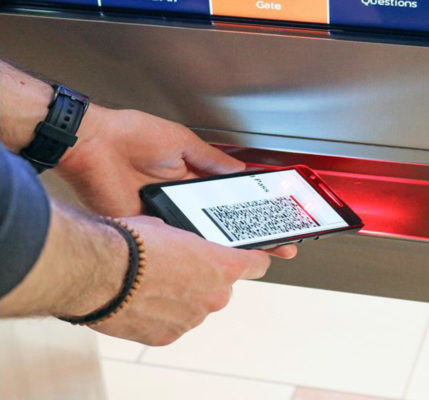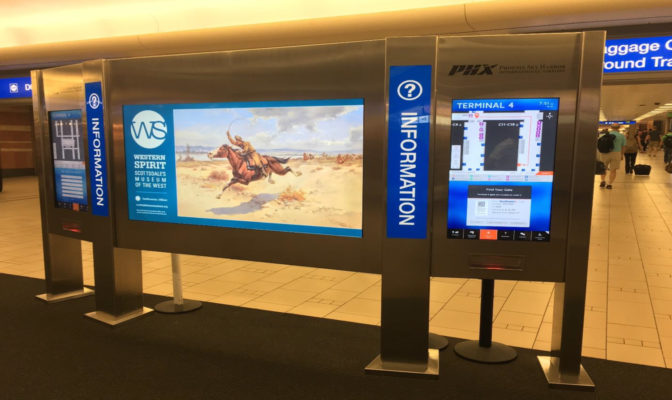Intelligent Wayfinding Keeps Visitors Moving

Editor’s Note: Nowhere is health and safety more critical than at hospitals, which have tightened operational protocols to protect every person on-site. Among other things, this means reducing interactions among staff, patients, and visitors.
Interactive wayfinding stations can help. They can automate critical services, including directions and routing, emergency alerts, and more.
22Miles already delivers these capabilities in settings like airports—as described in the article below. Now it is offering these same technologies to hospitals. And its wayfinding app is available to hospitals and healthcare organizations for free—along with no-charge tools and services for content, setup, and hosting.
Read on to see how airports use state-of-the-art interactive wayfinding, to enhance passenger experiences, and provide insights for airport operators. Then imagine how hospital operations can achieve the same benefits.
A growing number of travelers are passing more time than ever in airports. At the 25 busiest airports in the U.S., they experience on average over 60 minutes of flight delay time.
It’s not surprising that airport operators and concessionaires are looking for new ways to capitalize on passenger volume and retail opportunities. To do so, many are adopting the latest digital signage technologies to improve the customer experience and create new revenue opportunities.
Whether they’re looking to grab a bite to eat or shop at a particular store, passengers want the most efficient way to get to their gates and find what they need along the way. Fortunately, new mapping software, smart pathway algorithms, augmented reality, and interactive displays can now instantly help travelers find the perfect route to where they need to go.
“Airports are always trying to outdo one another, and one way they’re doing so is by innovating with digital signage solutions and mobile applications,” said Tomer Mann, Executive Vice President of Sales and Marketing at 22Miles.
Engaging Passengers with Digital Displays
Airports are now using state-of-the-art kiosks to improve wayfinding, enhance the passenger experience, and boost revenues at their restaurants and retail locations.
Norman Y. Mineta San Jose International Airport has deployed three robots—Norma, Amelia, and Piper—to inform and entertain travelers. While they provide directions and information, the three also engage people with new experiences. The robots play music, dance, take photos, and even ask for favors of passersby, as shown in Video 1.
Video 1. Norma the robot at work.
It’s not surprising that such an inventive project was deployed in the heart of Silicon Valley. Funded by airport concessionaires, the solution is a collaboration between 22Miles, a digital signage and wayfinding provider, and robot designer Future Robot.
Analytics Improve Passenger Experience
Phoenix Sky Harbor International Airport is another example of the 22Miles Interactive Wayfinding solution in action. With more than 120,000 travelers each day, the airport needed a better way for them to locate departure gates, restrooms, restaurants, and more. As part of a major terminal remodel, airport managers deployed 28 wayfinding kiosks throughout.
The interactive touchscreen kiosks are powered by Intel® NUCs—ruggedized, high-performance mini-PCs. Each system includes an intuitive question-oriented menu and 3D maps where travelers can easily find routes to their desired locations.
With dynamic map popups, users can quickly find descriptions and images, and a smart search capability allows them to locate destinations with a built-in keyboard.
A QR code reader allows passengers to scan their boarding pass and instantly take route and facility information with them. “They can scan their boarding pass and we can connect them to that API to immediately provide the wayfinding from where they are—no app required,” said Mann (Figure 1).

One of the greatest benefits for the Sky Harbor operations team is the solution’s Publisher Pro CMS tools, which gives managers insights about the user experience, such as what passengers seek and where they need the most help.
The analytics show how kiosks are used and how they benefit travelers. And with data collected through customer interactions, the airport has actionable information for better planning and decisions.
“In the last year and a half since the solution has been deployed, it has had almost 68 million button clicks within those 28 kiosks—an astounding number,” said Mann. “But that’s what the analytics are showing and the data speaks for itself. The system is benefiting travelers, shops, and restaurants across the terminal.”
And as a result, Sky Harbor continues to expand these services with new kiosks in additional terminals.
All-in-One Digital Signage Solution
The solution’s content management system’s intuitive design means that personnel can easily create and manage their own content. The system enables staff to:
- Develop and push content for promotions and advertising opportunities
- Build real-time 3D facility maps with pathways throughout the terminal
- Integrate existing third-party feeds such as flight information, which auto-syncs to the kiosk within minutes
“Simplifying signage management and enabling real-time updates and access to information makes wayfinding transparent, accessible, and accurate,” said Mann.
The solution can be deployed in any facility. 22Miles uses a digital copy of airport floor plans, then redesigns and optimizes it with all the relevant nodes and points of interest. The built-in 3D engine then creates a 360-degree map where a smart pathway algorithm can instantly figure out the fastest and most direct way to get from one point to another. And the modular kiosk design allows for customized configurations to maximize space and foot traffic across locations (Figure 2).

22Miles benefits from its partnership with Intel® in a number of ways. “Intel helps 22Miles develop next-generation platforms and bring them to market globally,” Mann said. “Working with Intel has really opened up the doors to a lot more opportunities and future innovations.”
“In the end, it means that we can create a simpler hospitality experience for travelers, making it more efficient, and driving more business across the airport,” he said. “And the bigger the airport, the more foot traffic, the more cluttered it could be, the more important wayfinding becomes.”